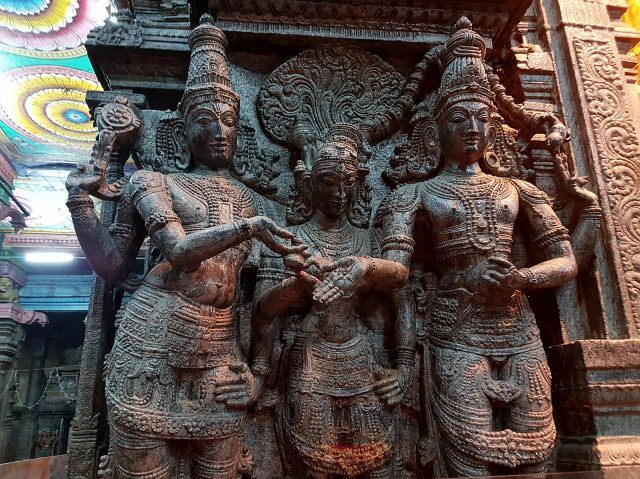
Abaddon
 26. 04. 2024
26. 04. 2024



 05. 10. 2021
05. 10. 2021

Ancient Meenakshi Temple rises above modern buildings in Madurai. The 14 towers of the temple are covered with more than 1 brightly painted statues, making Meenakshi Temple a rare and beautiful place.
Like many ancient wonders, the Meenakshi Temple was built for ancient deities. Interestingly, the Hindu goddess Meenakshi is the main goddess of the Meenakshi temple rather than Shiva, who is usually the main deity in South Indian temples.
Shiva is one of the main deities of Hinduism and is the supreme being in Shivaism (the main tradition in Hinduism). Meenakshi is Shiva's wife. According to legend, King Malayadwaja Pandya and his wife Kanchanamalai performed Yajna (a sacred Hindu ritual performed with fire) and asked for a son to follow them as ruler. However, a young girl, who was three years old and had three breasts, came out of the fire. King Malayadwaja and Queen Kanchanamalai, confused by their daughter's biological abnormality, began to worry. The gods intervened and told the new parents not to be afraid - they should raise this girl as a son, and when she met her husband, she would lose her third breast.

Statue of Shiva and Meenakshi wedding in Meenakshi temple. God Vishnu (figure on the left) gives his sister and bridges Meenakshi (middle) to the groom Shiva (right).
King Malayadwaja and Queen Kanchanamalai followed the advice of the gods. They raised their daughter to be a strong warrior, and in the end King Malayadwaja crowned her as his successor. When King Malayadwaja's daughter tried to attack northern India, she was confronted by the god Shiva, who lived on Mount Kailash, deep in the Himalayas. When she saw him, her third breast fell and she took on her proper form as the goddess Meenakshi. Meenakshi and Shiva got married and decided to make a home in Madurai, where they ruled (and continue to rule symbolically) as queen and king.
Hindus believe that this marriage between Meenakshi and Shiva was the largest event on Earth. The temple hosts an annual 10-day Meenakshi Tirukalyanam festival to celebrate the marriage of Meenakshi and Shiva. This celebration attracts more than a million people every year.
The oldest temple in Madurai was probably built in the 7th century AD Texts available to historians suggest that the temple was once a place where scholars met to discuss important topics. In the 14th century AD, the sacred temple was looted and destroyed by the northern Muslim general Malik Kafur. In Madurai and other South Indian cities, Kafur plundered and ravaged sacred temples in search of gold, silver, and precious stones. The site was empty for almost 250 years until the construction of another temple began.
In 1559, the first ruler of the Nayaka dynasty (Viswanatha Nayak) began construction of a new temple built on the same site as the original. The rulers who built the new temple followed the ancient craft and architectural laws known as Shilpa Shastras. According to these laws, the statues, icons, and paintings in this temple had to be made in a certain way to create an idealized divine body valued in Indian art. The temple, which was rebuilt by the Nayaka dynasty, is the one that remains in Madurai today.
Meenakshi Temple is a beautiful example of Dravidian architecture - the style of Hindu architecture typical of the southern states of India. Structures built in the Dravidian style often include covered porches in temples, tall entrance towers at the gates on two or more sides, many columned halls, and a water reservoir or ritual bathing tank.
The most remarkable features of the Meenakshi temple are the massive towers - or gopurams. Meenakshi Temple has a total of 14 gopurams, the tallest of which rises over 52 meters and was built in 1559. Each gopuram of Meenakshi Temple is a multi-storey building covered with thousands of brightly painted stone figures of animals, gods and demons. These sculptures are redrawn and repaired every 12 years.
Another interesting fact about the Meenakshi Temple is that when viewed from above, the whole structure represents a mandala. Mandalas are also painted on the inner ceilings of the temple. The temple also includes a hall in the temple complex. It remains an architectural marvel with two rows of richly carved pillars containing images of Yali - a mythical figure with an elephant's head and a lion's body. The Hall of Thousands of Pillars was built in 1569, but it is interesting that instead of 1000 pillars in the hall, there are actually only 985 of them.
The work, which has been preserved in the so-called Šastra language, is a unique "technical manual" for pilots of flying technical equipment (Vimaanika Shaastra), which was constructed millennia ago.
Despite the skeptical views of most of the scientific world on the history of the technical development of mankind, indications of the existence of long-extinct but technically very advanced civilizations are increasingly flashing into light.